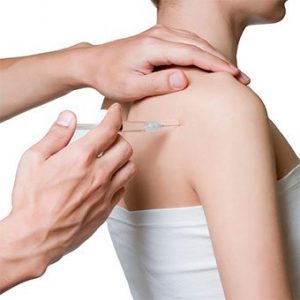The hip joint is one of the most important joints in the body in terms of freedom of movement and pain free mobility. Although this is ball-and-socket joint is extremely stable as a result of being anchored to the pelvis by tough ligaments, conditions which destabilise the the joint can arise and in may cases cause significant pain and discomfort.
Since the hip is implicated so strongly in overall movement and stability, sprains and strains to the lower back, knees or ankles can result in misalignment of the hip bones – its also possible to directly injure the hip joint, which makes this a problematic area for many of our clients.
The good news is that chiropractic care is ideally suited to identify the source of your hip pain and then treat the root causes. Today lets take a closer look at the reasons behind hip pain and what you can do to prevent it.
What Causes Hip Pain?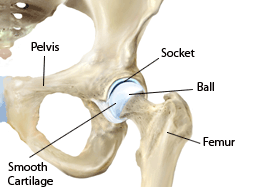
There are many possible causes for hip pain, however as suggested above with hip pain it’s especially important to get an idea of your history and any other pain you are experiencing, since referred pain (meaning that its source is else where in the body, such as the spine) is a common cause. If the pain is directly associated with the hip, there are a number of common conditions which are usually the culprit.
Vertebral Subluxations
When spinal bones (vertebrae) become misaligned, a common condition known as vertebral subluxation develops. Subluxation is the most common cause of back, hip and neck pain and is the first condition we check for when dealing with a new client. Chiropractic adjustments are a simple safe and pain free treatment for subluxation, which can reduce hip pain in many cases.
In one study, a patient undergoing chiropractic care experienced a decrease in the pain and an improvement in the flexibility and strength that led to an improved walking pat tern and decreased pain. [1]
Sacroiliac Joint Dysfunction
Located on each side of the sacrum (the triangular spinal bone below the lumbar vertebrae), the sacroiliac joints are susceptible to misalignment and strain. The result is pain in the lower back, buttocks and hip area. Chiropractic adjustments help realign the sacroiliac bones to resolve the issue.
Osteoarthritis
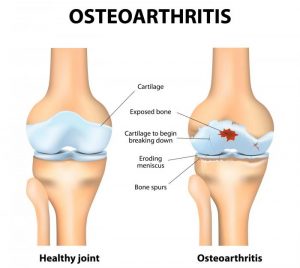
Development of osteoarthritis, here shown in the knee.
Osteoarthritis related pain can be constant or it might come and go with activity levels and the weather conditions. It can be the result of a previous trauma, or a gradual onset brought on by repetitive activity. Patients who are overweight are often more prone to arthritis than their leaner counterparts. Osteoarthritis leads to a degradation of the protective joint fluid, degenerative changes in the bones comprising the joint, and pain.
Osteoporosis
Osteoporosis, characterized by a loss of bone density, can also cause hip pain but also significantly increases your chance of fracture. Chiropractic care can help patients to maintain full range of movement and minimise any pain, but the key to controlling osteoporosis is participating in weight bearing activity.
Referred pain
We mentioned above that the hip, like the spine is interconnected with the whole body – which means that a problem in one location might actually cause pain elsewhere, as the body tries to compensate. It only takes one misaligned vertebra to launch a chain reaction which results in misalignment in the rest of the spine and eventually in the hips.
Short Leg
Many individuals have one leg that is slightly shorter than the other. Don’t panic, its perfectly normal! The leg may actually be physically shorter (known as an anatomical short leg), but more often than not the legs are physically the same length, but one seems to be shorter than the other due to pelvic misalignment. If the pelvis sits slightly higher on one side, the effect will be that the associated leg seems shorter. This disparity leads to a disproportionate amount of force being applied to one hip during walking and other activities. This in turn, predisposes that hip joint to pain.
These kinds of minor postural issues are easily and simply corrected at our clinic, and its why we offer postural analysis and correction wherever we think it might be helpful.
Steroid Use
Repeated steroid use – either orally or via injection – for pain relief may degenerate joint cavities. Steroids also reduce calcium absorption through the gastrointestinal tract, thus contributing to osteoporosis. In addition , they may cause a temporary or permanent loss of blood supply to the bones comprising the joint (a disease known as avascular necrosis). When this takes place, the bones erode.
Sometimes the use of steroids might be necessary in the short term, but as a chiropractic clinic we reject the use of medicines to mask back pain. Instead we prefer a targeted process designed to identify the problem and correct the route cause in a completely drug free way.
Especially in older individuals, its well worth considering weather drugs are the best way to go. Sometimes, the results are not always what you hope for! One case study following a 65-year-old woman suffering from hip pain who underwent injections of the steroid lidocaine. The results were disastrous. Instead of relief from her pain, the woman developed a disorder called septic arthritis.
According to the researchers from Johns Hopkins University School of Medicine, who cited her case in a journal article, “septic arthritis of the hip is a serious medical condition that can result in permanent joint dysfunction.”[2] .
Femur Fracture
A fracture of the head or neck of the femur itself can also cause considerable hip pain. If you or anyone in your family- particularly elderly relatives – suffers a nasty fall (especially at this time of year!), schedule an appointment to come into the clinic so we can check for any damage which might not immediately be apparent.
Other Conditions
There are numerous other conditions that may cause hip pain, such as congenital disorders and Fibromyalgia. If you’re suffering with hip pain, wy not make an appointment today so we can find out what’s causing your problem.
Additional Tips for Preventing Hip Pain
So what can you do on a day to day basis to avoid hip pain? Here’s some tips!
Walk Right
Foot placement during walking is referred to as you “gait”. An incorrect gait can spark hip pain and this might be especially true if you have feet with low or high arches. We offer postural and gait analysis which can allow us to spot and correct with simple exercises any issues before they become significant.
Be picky in the shoe department
Especially true for your everyday work shoes, our feet spend 8-9 hours a day in our shoes. Sub-optimal shoes may upset the alignment of the legs, in tum altering the dynamics of the hip joints. This seems like a minor point but you would be surprised how many clients we see with hip and lower back alignment issues which are actually caused by poor choice of shoes. Consider innersoles too, as a method of damping out any imbalances.
Take some time to stretch
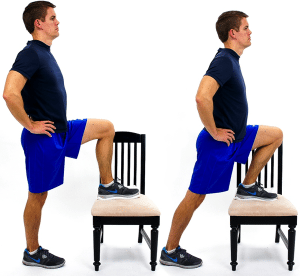
An easy hip flexor stretch
Certain sports activities, such as running and step aerobics, tend to strain the hip flexor muscles which can lead to hip pain. Strengthening the hamstrings muscles as well as a comprehensive stretching program may counteract this (and also help to reduce your risk of injury)
According to a study conducted by researchers from Thomas Jefferson University in Philadelphia, intensive hip stretching exercises reduced the risk of pain and missed ice time in eight competitive figure skaters with a history of hip flexor pain associated with repeated jumping . While your everyday exercise probably isn’t this intense, the fundamental point is the same!
Don’t sit on your wallet!
Lots of us, especially men, carry a wallet or another bulky item in their back pocket. While this might be slightly more convenient when you need to pay for something, over time, even this slight additional weight during walking can interrupt the balance of the hip joints. What ‘s more, sitting on a wallet also triggers misalignment.
If possible, carry your wallet in a front pocket, or at the very least take all those old receipts out!
Choose your seat carefully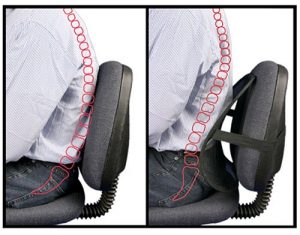
Many of us spend most of our day sitting in front of the computer as part of our jobs these days – but prolonged sitting may contribute to back and hip pain and injury by encouraging stiffness in the lumbar region of the spine[3]. This in turn can cause hip pain. Sitting for long periods of time also encourages poor posture, which can also contribute to hip pain.
If you’re going to spending a lot of time in a seat, try to make sure it fits you well and provides enough support. If you don’t have a choice of chair, there are many inexpensive devices available to improve the support offered by your seat.
For reference, a seat-back inclination of 110 to 130 degrees – together with lumbar support generates the least amount of pressure on the spinal discs in the lower lumbar region. Research also suggests that arm rests and a seat bottom that is five degrees lower in the back than it is in the front also help to reduce low-back pain [4] .
Kids and younger people get hip pain too
It not just older individuals who suffer with hip pain – like back pain, hip pain can affect everyone, even kids. In younger people, hip pain is often the result of sports in jury or stress from workplace related poor posture. Other possible causes include congenital hip dysplasia and trauma -such as a car accident. Other possible but less common causes at this age include rheumatoid arthritis, intravenous drug use, alcoholism or corticosteroid use[5].
Don’t suffer with hip pain
Hip pain can be especially debilitating regardless of your age or profession. There’s no need to suffer with hip pain as we are ideally positioned to help you beat hip pain once and for all. We help hundreds of people with hip pain every year, so why not make an appointment for an initial consultation today!
[1] JMPT 2004 ;27:479
[2] Clin Imaging 2003 ;27:225-8
[3] Spine J 2005 ;5: 1 45- 54
[4] JM PT l 999;22:594-609
[5] Clin Orthop Re/at Res 2004;418:9-17

